Search:
Powered by
Website Baker
The Battle of Pilot Knob (Fort Davidson) |
| Posted by The Muse (themuse) on Sep 26 2013 |
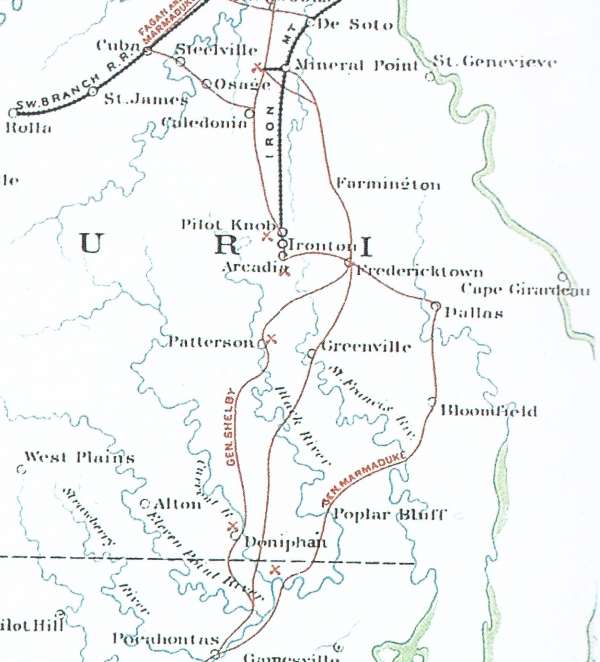
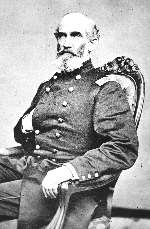 It may have been in Fredericktown where Sterling Price made a decision that would haunt him for the rest of the war. Price had received information that Federal Major-General A. J. Smith was on the outskirts of St. Louis with 8,000 infantry. He also had reports of a Federal garrison comprised of 1,500 men at Fort Davidson in Pilot Knob. Although his orders from General Kirby Smith recommended rapid movements, Confederate Major-General Sterling Price did not want the Federal garrison at Pilot Knob in his rear. After consulting with his lieutenants, Price decided to break off his advance on St. Louis and move against the Federals at Fort Davidson. [i]
It may have been in Fredericktown where Sterling Price made a decision that would haunt him for the rest of the war. Price had received information that Federal Major-General A. J. Smith was on the outskirts of St. Louis with 8,000 infantry. He also had reports of a Federal garrison comprised of 1,500 men at Fort Davidson in Pilot Knob. Although his orders from General Kirby Smith recommended rapid movements, Confederate Major-General Sterling Price did not want the Federal garrison at Pilot Knob in his rear. After consulting with his lieutenants, Price decided to break off his advance on St. Louis and move against the Federals at Fort Davidson. [i]
“I received at Fredericktown satisfactory information that the strength of the enemy at Ironton was about 1,500 and that the Federal General A. J. Smith was encamped about ten miles from Saint Louis with his corps, composed of about 8,000 infantry, on the Saint Louis and Iron Mountain Railroad. I immediately issued orders to Brigadier-General Shelby to proceed at once with his division by the way of Farmington to a point on the Saint Louis and Iron Mountain Railroad, where there were three fine bridges in close proximity to each other, and to destroy the railroad there and the bridges; after effecting that object to fall back in the direction of Ironton and Pilot Knob, which would effectually prevent General A. J. Smith from re-enforcing the garrison at those places, while I would attack and take them with the divisions of Major-Generals Fagan and Marmaduke.”
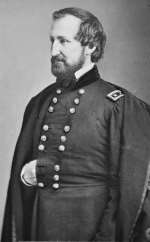
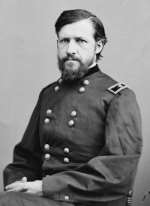
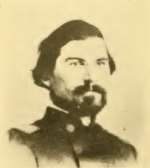
Major-General William S. Rosecrans, the Federal commander in Missouri had ordered Brigadier-General Thomas Ewing, Jr. down to Fort Davidson with reinforcements. After leaving men behind to guard the railroad bridges, Ewing arrived in Pilot Knob at twelve noon on September 26 with about 400 men from the 14th Iowa Infantry. Upon his arrival, Ewing conferred with his man on the scene, Major James Wilson. [ii]
“On reaching Pilot Knob at noon of Monday, September 26, I found scouting parties had been sent the night before on all the main roads, but that the party sent toward Fredericktown had returned after going but six or eight miles. I forthwith sent two companies to make a thorough reconnaissance toward Fredericktown, and a small scouting party … to cross the roads leading from the south to that place, and learn of the loyal people on them as much as possible as to the force of the enemy.”
On September 26, 1864 from Pilot Knob, Federal Brigadier-General Thomas Ewing, Jr. sent the following telegram to Major-General Andrew J. Smith, who was 25 miles north in Mineral Point. [iii]
“I am advised by Major Wilson, commanding at the front, that the rebels are massing a large force in his front in Arcadia Valley, two miles from here. There is no doubt that it is intended to attack here in large force. I think it advisable for you to send me a full regiment at once, as the fort is large enough to hold them efficiently in addition to the troops I have. Artillery enough in the fort and all inside.”
Ewing was under orders from his commanding officer, Major-General William S. Rosecrans, to evacuate Fort Davidson if he were facing Price’s whole army. To determine what the Confederates were up to, Ewing sent out a couple of reconnaissance forces south of Pilot Knob, who ran into a large enemy force. Although Ewing knew he faced a large enemy force, he still did not know if he was facing Sterling Price’s entire army. Ewing decided to make a stand at Fort Davidson. [iv]
“The advantages of delaying the enemy two or three days in his march northward and of making a stubborn fight before retreating were so great, even though the defense should be unsuccessful and much of the garrison be lost, that I resolved to stand fast and take the chances … I immediately forwarded up the railroad all the quartermaster and commissary stores not needed in the fort, and all the rolling-stock, and started the quartermaster’s wagons empty.”
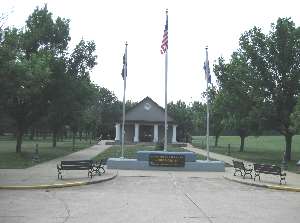 If you are interested in the Battle of Pilot Knob, you will want to visit the Fort Davidson State Historic Site located in Pilot Knob, Missouri. Or you could take a virtual tour of the Battle of Pilot Knob at the Civil War Muse website.
If you are interested in the Battle of Pilot Knob, you will want to visit the Fort Davidson State Historic Site located in Pilot Knob, Missouri. Or you could take a virtual tour of the Battle of Pilot Knob at the Civil War Muse website.
| Paperback Edition | Kindle Edition |
[i]OR Series 1, Volume XLI, Part 1, 627-628.
[ii]OR Series 1, Volume XLI, Part 1, 446-447.
[iii]OR Series 1, Volume XLI, Part 1, 445-447; OR Series 1, Volume XLI, Part 3, 385-386.
[iv]OR Series 1, Volume XLI, Part 1, 447; OR Series 1, Volume XLI, Part 3, 410.
Last changed: Sep 26 2013 at 8:02 AM
Back